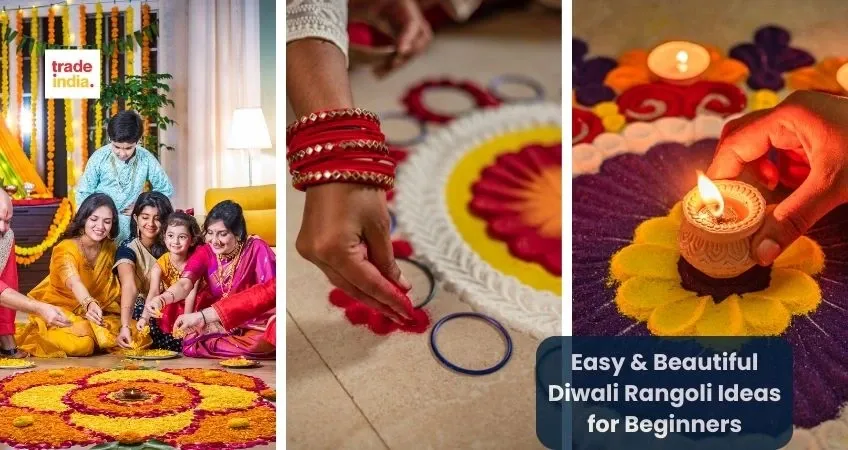Easy & Beautiful Diwali Rangoli Ideas for Beginners

Diwali, known as the festival of lights, is not merely a celebration of good triumphant over evil, but also a time when homes are sufficiently lit and adorned with colors, decorations, and joy. One of the most popular Diwali traditions includes patterning the floors with colorful powders, rice or flower petals in a beautiful craft known as Rangoli. Lasting Rangoli or Diwali Rangoli not only add an aesthetic beauty to your home but symbolizes prosperity, happiness and energy.
Whether you are new to Rangoli or simply looking for simple inspiration, we have put together a list of easy and beautiful Diwali Rangolis for you to try out this year. You will also find the latest Rangoli designs and trends, and light up this festive season!
Why is Rangoli Made During Diwali?
As per the Hindu beliefs & tradition, Goddess Lakshmi (the goddess of wealth), brings prosperity to the homes and work places that are clean, hygienic and beautifully decorated during the festival of Diwali. By making beautiful Diwali Rangoli in front of your house is the perfect way to invite the goddess and to bring good luck in your lives.
The History of Rangoli
Making Rangoli in the festivities is an ancient Indian tradition which was made using the natural products like turmeric, rice flour, flower petals and other such items. It is made to decorate the temples, sacred places and at the entrance of homes to attract positive energy.
In many regions of India, Rangoli is a daily ritual and a key element of festival decoration. Furthermore, the art form has transformed over the period of time, with the introduction of new types of designs, synthetic colors and stencils, but the main purpose of making Rangoli has not changed—to bring beauty, prosperity and spirituality.
Types of Rangoli
1. Classic Circular Rangoli
This is the most simple and trending design for Diwali Rangoli-an easy design for beginners. It's a simple, good looking very practical design and it works particularly well in the spaces you find at apartment entrance ways.
2. Easy Peacock Rangoli
Peacock patterns are always in vogue during Diwali, a festival of joy and light that symbolizes colours, beauty, grace and optimism.
3. Floral Rangoli with Petals
Flower petals are great for those who don’t like synthetic powders and kids. It’s good for people who wants a quick clean-up and mess-free Rangoli.
4. Diyas and Dots Rangoli
Of some of the easiest and oldest Diwali Rangoli designs to make in under 10 minutes. This design is ideal for someone who has more limited time.
5. Rangoli with Stencils
Using stencils for making Rangoli is an ideal option for the beginners who want to create beautiful Rangoli in a fast and symmetrical manner.
6. Minimalist Rangoli with White Powder
If you want to go with a traditional and clean look, choose white Rangoli made out of rice flour. This kind of minimalist Rangoli made mostly in South India.
Traditional Rangoli Patterns and Their Meanings
Each Diwali Rangoli carries symbolic meaning:
- Lotus Flower – Its symbolizes purity and divine connection. Also, used in Lakshmi puja.
- Peacock – It is considered as a symbol of pride, grace, and joy. A beautifully designed Peacock Rangoli often becomes the center attraction of Diwali decor.
- Swastika – Swastikais the symbol of good fortune, well-being and spiritual prosperity.
- Feet of Goddess Lakshmi – It is placed at the entrance of the home and other such places to signify the arrival of the goddess Lakshmi.
- Diya motifs – Represents victory of light over darkness, knowledge, enlightenment, etc.
Not only is Rangoli a form of art drawn for decorative purposes, it also has a religious and cultural significance in India.
1. Welcoming Prosperity
In India, Rangoli is drawn to receive Goddess Lakshmi, as she is the goddess of wealth and fortune. The blooming Rangoli at the entrance of the place gives “welcoming vibes to guests”.
2. Symbol of Auspiciousness
Rangoli designs usually consist of bright colors, unique designs and natural materials, such as rice flour, flower petals, or coloured powder which representes auspiciousness, sacredness, purity and harmony.
3. Bringing Joy and Creativity
Creating Rangoli is joyous activity and fun art expression for families and comes together to celebrate each other's artistic creativity and for fun. The colours, decorations and patterns liven up homes and warms people's hearts during the holiday season. Rangoli adds beauty and vibrancy into the festive season of celebration.
4.Warding Off Negativity
In addition to decoration, it is believed that Rangoli brings good luck and ward off evil spirits.
5.Cultural Heritage
Indian Culture is all about rangoli. It’s a tradition in the country for decades which shows our diversity. Rangoli creation narrate of culture, religions and festivities there are related.
Conclusion
Making a Rangoli is perhaps one of the celebrated and enjoyable traditions of the country. Whether it is traditional or modern Rangoli designs, ultimately it is about expressing your feelings through the designs & patterns while sharing positivity.
Be gentle on yourself; you don’t need to be an artist to create beautiful Rangoli. All you need is a little patience, some influence and lots of festive spirit. Polar opposite designs by vibrant peacock Rangoli to flower Rangoli or simply dots and diyas, your Rangoli will bring light to your home and your heart.
FAQ's : Diwali Rangoli Ideas
1. What are the different types of Rangoli designs?
The different types of Rangoli includes the following:
- Floral Rangoli
- Freehand Rangoli
- Geometric Rangoli
- Mandala Rangoli
- Natural Material Rangoli
- Peacock Rangoli
- Religious and Mythological Rangoli
2. What is the significance of Rangoli in Diwali?
Rangoli is a traditional art form that weaves the magic of colours on a floor canvas to welcome guests and Goddess Lakshmi into the homes, and sometimes in offices or other places as well for Diwali because Goddess Lakshmi showers wealth and prosperity. It represents positive, wealth, auspiciousness and good luck.
3. What materials and colours should be used for making the Rangoli?
Best Rangoli Colours The best colours for Rangoli These are natural elements around you can use for your design – turmeric (yellow), rice powder or crushed sands (for white) Green leaf vegetables can be used grains and pulses Red rose petal, sunflower petals add to the beauty of it. Rotating through the best of these materials; dry rice flour, coloured sand, quartz powder, powdered limestone red ochre, flower petals and coloured pebbles.
4. Is it possible to make eco-friendly Rangoli designs?
Yes, we can make rangoli using Eco-friendly materials such as flowers, rice flour, pulses and grains etc.
